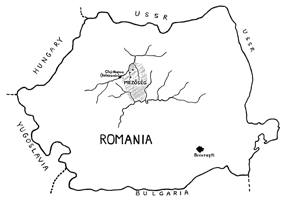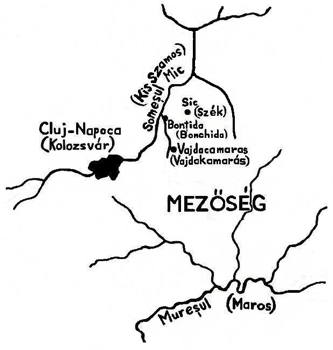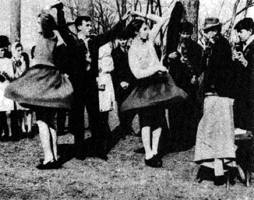
|
The Society of Folk Dance Historians (SFDH)
Hungarian Dances of Transylvania
[
Home |
About |
Encyclopedia | CLICK AN IMAGE TO ENLARGE |

|

ERDÉLYI TÁNCOK
Erdélyi Táncok (Hungarian Dances of Transylvania) possess a dual characteristic of being extraordinarily developed while still preserving very archaic features. This is because, in part, to the isolation of this area that favored the survival of old traditions. Escaping the Turkish invasions helped to ensure undisturbed cultural development. Thus, the new-style folk songs and dances spread very slowly in Transylvania.
When speaking of Transylvania, one is referring to the southeastern-most terminus of Medieval Hungary. Geographically, the Carpathian Mountain Range forms its natural eastern border, Presently, this area is situated in Romania.
Many ethnic groups settled and lived together in this region, the most prominent being the Hungarians, Romanians, Germans (or Saxons), and Romani. This ethnic variety has produced a most interesting and diversified peasant culture. There are areas where one can find interaction among different ethnic groups and a blending of traditional elements, as well as areas of regional and cultural separation wherein each ethnic group developed its own peculiar features.
This regional separation is evident in the folk dances of Transylvania. Many regional dance dialects can be readily distinguished. One such dialect is that of the Mezőség.
MEZŐSÉGI TÁNCOK
 Mezőségi Táncok (Dances of the Mezőség – mező = field or farmland) is situated between the rivers Someșul Mic (Kis Szamos in Hungarian) and Mureșul (Maros in Hungarian), northeast and east of the city of Cluj-Napoca (Kolosvár in Hungarian). Within this area there is a large Hungarian-speaking population living both in strictly Hungarian-speaking villages, as well as in villages of mixed populations (Hungarian, Romanian, and Romani).
Mezőségi Táncok (Dances of the Mezőség – mező = field or farmland) is situated between the rivers Someșul Mic (Kis Szamos in Hungarian) and Mureșul (Maros in Hungarian), northeast and east of the city of Cluj-Napoca (Kolosvár in Hungarian). Within this area there is a large Hungarian-speaking population living both in strictly Hungarian-speaking villages, as well as in villages of mixed populations (Hungarian, Romanian, and Romani).
The Mezőségi dances are a set of dances called táncrend (dance cycle) that is based on the songs and dance forms originally performed in such Mezőségi villages as Magyarpalatka and Vajdakamarás. These dances are popular not only among the Hungarian-speaking people (and in recent years, especially among the youth) of Transylvania, but also in the "táncház" (literally "dance house") movement in Hungary. The dance cycle as it is done in the táncház was introduced by Sándor Timár.
The dance cycle in its original form is composed of two men's dances: the Ritka Magyar (rare Hungarian) and Sőrő Magyar (Hungarian beer), followed by two couples' dances: the Akasztós (limping or dragging) and the Csárdás (roadside tavern and restaurant). The Akasztós is also known as the Cigánytánc (Romani dance), and is characterized by its slow asymmetrical rhythm. The Csárdás is subdivided into the Ritka csárdás, Szőkős, and Sőrő csárdás, which are structurally similar but differ in style, tempo, and melody.
Of all the dances of the cycle, usually only the Akasztós and Csárdás are seen today in the dance houses of Transylvania and Hungary. The men's dances are rarely performed and seem to be dying out, as is the case with other men's dances of this region.
The dance begins with couples standing and singing in front of the musicians. Gradually, each couple starts to dance the Akasztós, with walking steps forward and back, followed by turning together with the limping step that characterizes this dance. The musical transition into the Csárdás is signalled by the quickening of the tempo and the change to an even rhythm. The transition from the Akasztós turn into the Csárdás is usually a simple walking rida (a combination of a side-step and a cross-step) couple's turn continuing in the same direction as the couple was moving in the Akasztós.
MEZŐSÉGI CSÂRDÂS
There are seemingly endless variations to play with in the Csárdás. Some are more suited to particular tempos than others (such as doing Double Turns during the Szőkős), but this is also somewhat dependent on the level of expertise of the dancers. There is no hard and fast rule as to what step is done when. As you experiment with the many possibilities, you will undoubtedly create favorite sequences all your own!
For teaching purposes, divide the Csárdás steps into the following categories:
- Ávetős Variations
- Throw Sequences
- Throw-and-Turn Sequences
- Men's Steps:
Couple Together Variations
Couple Separation Variations
Steps within categories can be done any number of times, and categories of steps can be done in any order. Some steps "cross phrases" (for example, a step may take one and a half measures), so the step that follows begins in the middle of the phrase.
The man is responsible for choosing the steps to be done; this includes giving the woman the appropriate "signals" to that she can follow his lead. You will see that certain steps follow others more easily, and this will probably (but not necessarily) guide your choice of sequences. Generally, a dancer tries to construct the dance so that it has peaks (high-energy parts) and valleys (low-energy parts) interspersed. This gives the dance color and dynamics, as well as being practical.
DOCUMENTS
- Hungary, a country.
- Romania, a country.
- Mezőségi Táncok, a dance.
- Transylvania, a region.
Printed in the Kolo Festival Syllabus, November 1982.
This page © 2018 by Ron Houston.
Please do not copy any part of this page without including this copyright notice.
Please do not copy small portions out of context.
Please do not copy large portions without permission from Ron Houston.